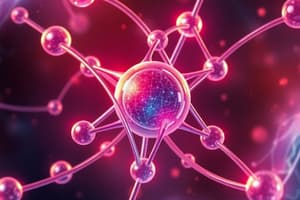Podcast
Questions and Answers
What is the smallest unit of matter capable of independent existence?
What is the smallest unit of matter capable of independent existence?
- Neutron
- Proton
- Electron
- Atom (correct)
Which part of an atom contains most of its mass?
Which part of an atom contains most of its mass?
- Nucleus (correct)
- Protons
- Electron cloud
- Neutrons
What part of an atom has a positive electrical charge?
What part of an atom has a positive electrical charge?
- Neutron
- Nucleus
- Proton (correct)
- Electron
Which element is mentioned as the lightest in the text?
Which element is mentioned as the lightest in the text?
Where do electrons reside in an atom?
Where do electrons reside in an atom?
How are elements arranged in the periodic table?
How are elements arranged in the periodic table?
What physical properties do elements within the same group tend to have?
What physical properties do elements within the same group tend to have?
Which element, belonging to Group 2, gives off heat upon reaction and forms a liquid?
Which element, belonging to Group 2, gives off heat upon reaction and forms a liquid?
What determines whether oxygen would produce gases, liquids, or solid compounds during reactions?
What determines whether oxygen would produce gases, liquids, or solid compounds during reactions?
What type of bond forms when two atoms share valence electrons?
What type of bond forms when two atoms share valence electrons?
How many pairs of electrons are shared in a triple covalent bond?
How many pairs of electrons are shared in a triple covalent bond?
What is the main purpose of understanding atoms and molecular structure in chemistry?
What is the main purpose of understanding atoms and molecular structure in chemistry?
Flashcards are hidden until you start studying
Study Notes
Understanding atoms and molecules is fundamental to chemistry because they make up everything around us. An atom is the smallest unit of matter capable of independent existence, while a molecule consists of two or more atoms chemically joined together. In this article, we will explore some basic concepts regarding atomic structure and how atoms interact with each other to form larger structures called molecules.
Atomic Structure An atom has three main parts: the nucleus, protons, neutrons, and electrons. The nucleus contains most of the mass of the atom and is made up mostly of protons and neutrons held together by nuclear force. Protons have a positive electrical charge while neutrons are neutral; therefore, the only negatively charged part of the atom is its electron cloud where electrons orbiting the nucleus reside. Electrons move in shells surrounding the nucleus like planets moving around the sun. Each shell can hold varying numbers of electrons depending on their energy level, allowing them to shift from one energy level to another when reacting with another element. The lightest element, hydrogen, has one proton, one neutron, and one electron, making it the simplest atom.
The Periodic Table As you might remember from school, elements are arranged according to their relative weights in the periodic table, which shows all known chemical elements listed horizontally across rows known as periods, and vertically down columns known as groups. Elements within a group tend to have similar physical properties. For example, sodium and calcium belong to Group 2, characterized by metal properties such as conductivity and reactivity towards water. Sodium gives off heat upon reaction and forms a liquid, whereas calcium forms solids. Similarly, oxygen belongs to Group 16, producing gases, liquids, and solid compounds based on their temperature and pressure during reactions.
Chemical Bonds between Atoms When two atoms come close enough to share valence electrons, they form what's called a chemical bond. There are many types of bonds including ionic, covalent, metallic, etc., but three common ones include single, double, and triple covalent bonds. Single bonds consist of sharing one pair of electrons between two atoms, doubles involve sharing two pairs, and triples involve sharing three pairs. These bonds link large molecules into bigger structures, like DNA strands holding our genetic code.
In summary, understanding atoms and molecular structure helps scientists explain why things behave differently under different conditions - whether chemicals in solution or in physical form. Moving forward in chemistry often involves manipulating these tiny building blocks to create new materials or processes to improve life quality or solve problems.
Studying That Suits You
Use AI to generate personalized quizzes and flashcards to suit your learning preferences.




